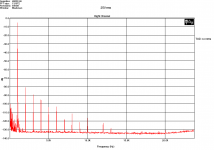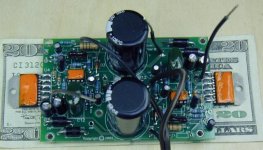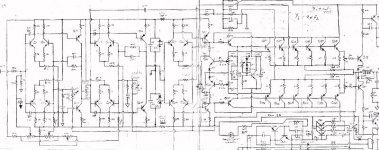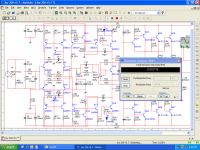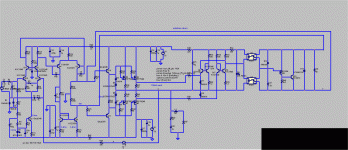Or put it another way, it has been claimed that distortion harmonics are significantly less objectionable if they follow a clear decreasing trend from 2nd to 3rd and so on. Would the higher order harmonics be as audible in this case.
Hi,
you mean something like this, for sure:
Attachments
I was forced to work with the LM3886. I still have a large set of measurements. This stuff is a real crap, both sonically and in parameters. Good just for beginners.
Dear Ms. Eva,
please try also higher harmonics (in a controlled test).
I would add my results:
1% of 2nd H is at the edge of audibility
1% of 3rd H is distinguishable and audible
1% of 4th and higher H is horribly audible
0.1% of typical classB crossover distortion is easily audible.
Best regards,
I am not sure I agree with these figures.
Let us make something absolutely clear first:
I do not belong to the golden ear/subjectivist clan, and I would classify myself as a typical tin-eared guy.
And anyway, I never use listening tests to assess anything seriously.
But, a number years ago, I was setting up a low distortion FM discriminator.
A 1KHz signal was used for the test and I used a distortion-meter to control the result. I wanted to find the optimum setting for a double tuned quadrature demodulator, which was capable of under 0.1% THD.
There was also a monitoring amplifier/ speaker connected at the output, and to my amazement, I noticed I could sort of "detect" very small amounts of distortion on the pure sinewave.
As it seemed suspicious, I set up a crude "blind test": I disconnected the distortion meter, and made the adjustment only by ear a number of times, then checked the actual figure with the meter.
I consistently got results in the 0.1% region.
The figure in itself has nothing particularly striking: a nasty crossover artefact can be heard easily at levels significantly lower than that, but the effect of a misadjustment of the second coil of such a demodulator is very soft, and only increases the level of even harmonics, mainly the second.
Now, this test is only indicative, and there are a lot of arguments that could be used to dismiss it: a pure 1KHz sinewave is unrealistic, I was "looking for" and expecting something, there was a sort of dynamic feedback between the hearing and the movement of the hand adjusting the screwdriver, but anyway, I would recommend anyone to try it: it shows that even harmonics are not necessarily pleasant, undetectable or benign.
PS
I don't like the sound of single ended amplifiers, at least the ones that display significant amounts of objective distortion.
Last edited:
That would be the LM3886-based composite amplifier he claims to have designed and built. Apparently it has 100dB of global feedback at 10kHz and is unconditionally stable into any load, with no output inductor.Excuse me, 125dB at 10Khz? 225dB at DC? Are you sure? It seems quite far from practical. Where is so much gain coming from and how it is made stable?
A remarkable achievement indeed, especially as he claims to have designed it eight years ago, but didn't know what group delay was until last month. See here.
That would be the LM3886-based composite amplifier he claims to have designed and built. [/URL]
And it's not a gainclone, nor for beginners. I've seen LM1875's tucked inside the feedback of precision op amps 20 years ago. Distortion just went away.
I don't know about 100dB of global feedback at 10k, though. It was probably less.
The 0.001 ohm output impedance figure at 20khz is unrealistic. That would be a damping factor of 8000 at 20khz. .
A "little" mistake by an order of magnitude.
But still 8000 below 2khz, the freqency of roll off.
Attachments
Excuse me, 125dB at 10Khz? 225dB at DC? Are you sure? It seems quite far from practical. Where is so much gain coming from and how it is made stable?
Yes that is it. Now 8 years back. A practical composite amplifier. Have 100 in the field which have been turned on since install and have given no trouble of any kind. I do see a few changes to enhance performance now though. Excellent sonics none the less.
But this is off topic of the symmetric circuit amplifier. The schematic is for an "early" high symmetry amp from the 70's. Highly symmetric and yet today still so very popular.
Not everyone uses the present popular electronic models and formula for calculation of filters and an amplifier is simply a filter with gain. Just because I do not happen to use those does not mean I do not know what I am doing thank you. I am a physicist and not an engineer so as usual for us physics guys- we tend to look at things differently. Physics is the direct study of nature and not electronics in particular.
As anyone can see there is not much to this composite amp with servo. Checked the gain calculation and the LP is set to 106kHz for compensation so the gain claimed should be very close to correct via direct measurement.
What I wonder about is why it is so important to say that I am wrong or that I do not know. I see we disagree but that does not automatically mean I am wrong and someone else is correct. Please all, it used to be the earth was flat and square and most of the learned ones agreed. This is how I see some here with their flat earths. Allow us the chance to learn and review from one another without these items which prick the ears of the moderators. I have sworn off that behavior and hope I never trip again.
Attachments
Three symetrical differentials + vas in serial..
The accuphase P300 did use two, back in the 70s,
but each one with its own negative feedback loop,
and no global loop.
Since a single such stage can provide some 80dB open
loop gain without too much effort, ,i guess that the 225db
gain at DC is quite realistic...
The accuphase P300 did use two, back in the 70s,
but each one with its own negative feedback loop,
and no global loop.
Since a single such stage can provide some 80dB open
loop gain without too much effort, ,i guess that the 225db
gain at DC is quite realistic...
The schematic you show is completely unrelated to the thing in the photo, which is what you claim to have designed and are attempting to sell in the commercial sector of this forum.The schematic is for an "early" high symmetry amp from the 70's.
As anyone can see, the schematic you provided is not a "composite amp with servo".As anyone can see there is not much to this composite amp with servo.
Regarding the amp that you claim to have designed and built, you have made it clear in various threads that you are not prepared to show the schematic, you are not prepared to share any technical details as to how it works, you don't have any measurements or test results , and you can't even offer any meaningful specifications.
Is there any point in mentioning it here, other than to bolster your claims of expertise or perhaps promote a sale?
The highly symmetric amp is the thread subject so this early version schematic, 1974, belongs here and could be of interest to some.
For LM3886 composite amp specs please see the thread:
http://www.diyaudio.com/forums/chip-amps/163385-so-just-how-good-can-chip-amp-8.html#post2134582
where that information belongs. I mention this chip amp here because of the high gain brought up earlier and this composite amp does have very high gain so is related to the subject of discussion of that post.
For LM3886 composite amp specs please see the thread:
http://www.diyaudio.com/forums/chip-amps/163385-so-just-how-good-can-chip-amp-8.html#post2134582
where that information belongs. I mention this chip amp here because of the high gain brought up earlier and this composite amp does have very high gain so is related to the subject of discussion of that post.
Last edited:
Hi Carlos,
One thing i would like to appreciate is about Selenium speakers from brazil, where ever i use them i get full satisfaction in terms of performance. Even giants like jbl/das dont stand a chance against those drivers. And they also are nicely priced, dont cost a fortune.
I love seleniums😀
One thing i would like to appreciate is about Selenium speakers from brazil, where ever i use them i get full satisfaction in terms of performance. Even giants like jbl/das dont stand a chance against those drivers. And they also are nicely priced, dont cost a fortune.
I love seleniums😀
Attachments
Last edited:
Thank you Workhorse, they are good...also Bravox is very good too
They are old and skilled about speaker manufacturing, also they have some immunitty related fashion things...you can find same speaker you found in the seventies...the material to produce the magnets evoluted with time, naturally, the magnet size too...material used to produce coils evoluted, now square cross section ( people told me they did, alike Pioneer down the eigthies, not sure about that), suspended weigth reduced using other metal as coil core.... new material to the cones and suspension and rubber inside the wire that connects coil to the input jacks, this, as you know avoid vibrations, ressonances that may transmitt modulating tones to the diafragm...also they have included a metal cap into the back hole used for cooling and another kind of cap that let the air cross in the top cover, diafragm side.... there's no unobtanium features, no golden plated fool in you connectors, no unnecessary features offered to deceive customers, spartan style, alike Sparta warriors, no props or decorations that do not serve to better sound reproduction... honest product, decent product.
Old style paper cone, but fiber has a prefered direction and reinforcements to avoid distort the diafragm during aceleration.... the colour orange (red and orange colour mixed, or Coral colour) was keept as a tradition..also real specifications, RMS continuous tones power specified, not IHF, not peak, not transient pulses.
I know they are spread all over the world, and some forum friends, from your country, are representatives of this brand in your country too.
Very old style, needs some softening..some burn in time....but noiseless..you can play 8 hertz tone without listen the speaker....as 8 hertz is below our audition threshold.... we cannot listen sound when playing 8 hertz tone, exception is when the speaker is no good...neither mechanical movement generated sounds...only some disturbance in our ears... air pressure only... and that's the way the speaker is tested before packing...if microphone detect mechanical noises, then the speaker is not aproved and return to the laboratory in the place to go to packing and shipping.
You can see, in this video a bad speaker construction... watch the coil core, the awfull technique used for manufacturing:
http://www.youtube.com/watch?v=VN0tmyyC0ak
regards,
Carlos
They are old and skilled about speaker manufacturing, also they have some immunitty related fashion things...you can find same speaker you found in the seventies...the material to produce the magnets evoluted with time, naturally, the magnet size too...material used to produce coils evoluted, now square cross section ( people told me they did, alike Pioneer down the eigthies, not sure about that), suspended weigth reduced using other metal as coil core.... new material to the cones and suspension and rubber inside the wire that connects coil to the input jacks, this, as you know avoid vibrations, ressonances that may transmitt modulating tones to the diafragm...also they have included a metal cap into the back hole used for cooling and another kind of cap that let the air cross in the top cover, diafragm side.... there's no unobtanium features, no golden plated fool in you connectors, no unnecessary features offered to deceive customers, spartan style, alike Sparta warriors, no props or decorations that do not serve to better sound reproduction... honest product, decent product.
Old style paper cone, but fiber has a prefered direction and reinforcements to avoid distort the diafragm during aceleration.... the colour orange (red and orange colour mixed, or Coral colour) was keept as a tradition..also real specifications, RMS continuous tones power specified, not IHF, not peak, not transient pulses.
I know they are spread all over the world, and some forum friends, from your country, are representatives of this brand in your country too.
Very old style, needs some softening..some burn in time....but noiseless..you can play 8 hertz tone without listen the speaker....as 8 hertz is below our audition threshold.... we cannot listen sound when playing 8 hertz tone, exception is when the speaker is no good...neither mechanical movement generated sounds...only some disturbance in our ears... air pressure only... and that's the way the speaker is tested before packing...if microphone detect mechanical noises, then the speaker is not aproved and return to the laboratory in the place to go to packing and shipping.
You can see, in this video a bad speaker construction... watch the coil core, the awfull technique used for manufacturing:
http://www.youtube.com/watch?v=VN0tmyyC0ak
regards,
Carlos
Last edited:
Other test results
Mr. Godfrey, on this same subject of my post in "how good can a chip amp be?" on my LM3886 test results, would you be so kind as to point me towards your post showing your test results of square wave into horrible loads, THD, slew, noise, and so on for all amps you have built and posted results for? Would really like to see those just as you wanted to see mine. Schematics also if you please. I have no interest in simulation results. Real test please. Just answer right here with the post links. That would be great and thanks!
-Sum
<snip>
Regarding the amp that you claim to have designed and built, you have made it clear in various threads that you are not prepared to show the schematic, you are not prepared to share any technical details as to how it works, you don't have any measurements or test results , and you can't even offer any meaningful specifications.
<snip>
Mr. Godfrey, on this same subject of my post in "how good can a chip amp be?" on my LM3886 test results, would you be so kind as to point me towards your post showing your test results of square wave into horrible loads, THD, slew, noise, and so on for all amps you have built and posted results for? Would really like to see those just as you wanted to see mine. Schematics also if you please. I have no interest in simulation results. Real test please. Just answer right here with the post links. That would be great and thanks!

-Sum
Last edited:
I haven't made any extravagant claims, so don't need anything to back them up.
Excuse me, you have made "extravagant claims" about me, my designs, and those designs behavior. What about those? Are you now retracting those claims? I have written nothing but fact.
Enjoy🙂
No, I simply repeated some of your claims for Eva's benefit, since she asked about your amp.Excuse me, you have made "extravagant claims" about me, my designs, and those designs behavior.
As you have now done some tests and posted the results, my comments in that regard are obviously no longer valid.
Your apology is most humbly accepted, thank you.
I have a new discrete amp am working on and will post those results when I get it going. It should be much better and more stable as there is a choice to have high output current and wide bandwidth. Its discussion is in the thread by ApexAudio here:
http://www.diyaudio.com/forums/solid-state/164093-100w-ultimate-fidelity-amplifier-5.html
Regards to all, -Sum
I have a new discrete amp am working on and will post those results when I get it going. It should be much better and more stable as there is a choice to have high output current and wide bandwidth. Its discussion is in the thread by ApexAudio here:
http://www.diyaudio.com/forums/solid-state/164093-100w-ultimate-fidelity-amplifier-5.html
Regards to all, -Sum
Gender propaganda
Even if someone is shemale, you will never find out atleast on this forum.😀
Carlos is simple guy, who loves building amplifiers and sharing his creativity with all of us with fun🙂
Eva,
May I ask you a question?
Are you male, or female?
Hugh
Even if someone is shemale, you will never find out atleast on this forum.😀
Carlos is simple guy, who loves building amplifiers and sharing his creativity with all of us with fun🙂
Wow, this thread is playing ping pong with my brain. First symmetrical amp virtues , pick on carlos , chip amps , psychoacoustics ,... everything.
I tried a leach clone , it was reliable. BUT , I had to try them all. Self , bootstrapped RCA (oldie ), then symasym and folded cascode symasym (roenders amp). It was a very good experience to go through all those topologies. To compare their sound is at most an exercise in subjectivity unless you screw up and mis-design one or end up with melted sand.

This forum is so full of good designs , why not use all the different output stage and front- end topologies as building blocks. Even to the point of "plugin" LPT/VAS modules. Want to compare a leach to a symasym ? , unplug one and then plug in another (A / B direct ... a little less subjective).
I took a vacation from the forum for a few months , very little innovation. I now want to attack the "holy grail " of class B amps - Xover distortion . It is as big a factor as topology in the final sound. I tried the krill , too hot ,tanaka's scheme was too involved but good , finally I will try E. Stuarts active bias controller WITH MOSFETS. (picture below - amp is real , I am listening now .. just have to build the bias control )
,tanaka's scheme was too involved but good , finally I will try E. Stuarts active bias controller WITH MOSFETS. (picture below - amp is real , I am listening now .. just have to build the bias control )
OS
I tried a leach clone , it was reliable. BUT , I had to try them all. Self , bootstrapped RCA (oldie ), then symasym and folded cascode symasym (roenders amp). It was a very good experience to go through all those topologies. To compare their sound is at most an exercise in subjectivity unless you screw up and mis-design one or end up with melted sand.


This forum is so full of good designs , why not use all the different output stage and front- end topologies as building blocks. Even to the point of "plugin" LPT/VAS modules. Want to compare a leach to a symasym ? , unplug one and then plug in another (A / B direct ... a little less subjective).
I took a vacation from the forum for a few months , very little innovation. I now want to attack the "holy grail " of class B amps - Xover distortion . It is as big a factor as topology in the final sound. I tried the krill , too hot
 ,tanaka's scheme was too involved but good , finally I will try E. Stuarts active bias controller WITH MOSFETS. (picture below - amp is real , I am listening now .. just have to build the bias control )
,tanaka's scheme was too involved but good , finally I will try E. Stuarts active bias controller WITH MOSFETS. (picture below - amp is real , I am listening now .. just have to build the bias control ) OS
Attachments
- Status
- Not open for further replies.
- Home
- Amplifiers
- Solid State
- Symetrical schematics are alike plague in Brazil, do you like them?
